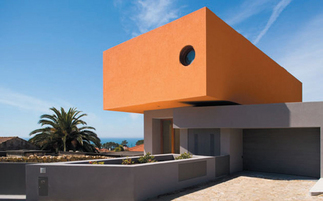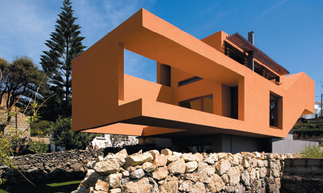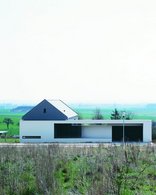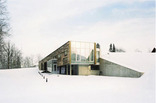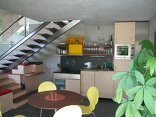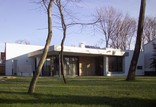Bauwerk
Orange House
Pedro Gadanho, Nuno Grande - Carreço, V. Castelo (P) - 2005

Weekend retreat, Carreço
Pedro Gadanho and Nuno Grande give their personal view of the house they designed together.
13. September 2006 - Nuno Grande, Pedro Gadanho
Pedro Gadanho:
Architect João Luís Carrilho da Graça once stated that orange was the new black. Perhaps it is now the new white? At least, orange certainly confounds the myth of white as an equivalent of abstraction. But is orange less abstract? Painters would say no. Colour symbolists would say otherwise. Perhaps. Yet – apart from uncannily contextual reasons – orange is, after all, just as provocative and sexy a way to stress and mediate and promote what is not so obvious in contemporary production.
Think. What may, ultimately, no longer be so obvious to architectural „analphabets“? The emotional force of the cantilever, the ironic memoirs of French film auteurs, the twisting of reality/landscape to fit the artificial architectural frame, the impact of the pure gaze, the expression of viscerality. Gibberish, in fact. Aesthetic pleasure in reverse. Or maybe not. After all else has become aestheticized, aesthetic pleasure certainly has to come with a twist. Maybe that pleasure is the anarchic pleasure of subverting rules – which only those who master the rules can truly achieve. (Of course, I only mean those glorified engineers known as „architects“ as opposed to „builders“, but if an erudite example is required just remember that column that doesn’t reach the ground under Siza’s Bonjour Tristesse in Berlin.)
If you produce the unnameable, then you get away with crime. If your cantilever – or your concept – doesn’t fit the categories that legislation finds appropriate, then maybe you can just get away with it. And subversion saves your project from being just another object deformed and amalgamated by convention. Legal and otherwise. The latest Pritzker Prize winner, Paulo Mendes, would say that you have to create problems in order to solve them. Welcome problems.’
Nuno Grande:
‘For a long time, our Orange House seemed quite strange to a lot of people. Strange to us, as brandnew architects coming (or running) from the respectable and purist Porto Architectural School. Strange to the patient owner who wanted a beach house and got an urban one; strange to the local fishermen whose ancient lighthouse was partially hidden by the new rectangular volume. Strange to the unpleasant neighbour who, from the other side of the street, kept a suspicious surveillance, facing the gaze of the „monster’s“ only eye. Strange to the brave structural engineer who prayed that the almost eightmetre balcony cantilever would not collapse. Strange to the friendly visitors who could never agree on why they liked that loud orange colour so much! And yet, what was so strange became familiar after all.
Now finished, the house is orange on the outside but quiet when you see it from the inside – like an „inverted egg“, a kind of perversion of the normal building process: white concrete inside, coloured plaster outside.
The proud structural engineer is now using the long balcony as a case study for his civil engineering university course. The besieged neighbour has lost his „battle“ and hasn’t been seen since (swallowed by the monster perhaps?). The fishermen are already used to the strange shapes created by the illuminated voids of the house at night. The owner convinced his wife to move from the big city and stay for longer weekends. And we? Well, we are now living in different cities but we are both teaching at the still respectable (but hopefully less purist) Porto Architectural School. Times, like colours and people, keep changing.’
Architect João Luís Carrilho da Graça once stated that orange was the new black. Perhaps it is now the new white? At least, orange certainly confounds the myth of white as an equivalent of abstraction. But is orange less abstract? Painters would say no. Colour symbolists would say otherwise. Perhaps. Yet – apart from uncannily contextual reasons – orange is, after all, just as provocative and sexy a way to stress and mediate and promote what is not so obvious in contemporary production.
Think. What may, ultimately, no longer be so obvious to architectural „analphabets“? The emotional force of the cantilever, the ironic memoirs of French film auteurs, the twisting of reality/landscape to fit the artificial architectural frame, the impact of the pure gaze, the expression of viscerality. Gibberish, in fact. Aesthetic pleasure in reverse. Or maybe not. After all else has become aestheticized, aesthetic pleasure certainly has to come with a twist. Maybe that pleasure is the anarchic pleasure of subverting rules – which only those who master the rules can truly achieve. (Of course, I only mean those glorified engineers known as „architects“ as opposed to „builders“, but if an erudite example is required just remember that column that doesn’t reach the ground under Siza’s Bonjour Tristesse in Berlin.)
If you produce the unnameable, then you get away with crime. If your cantilever – or your concept – doesn’t fit the categories that legislation finds appropriate, then maybe you can just get away with it. And subversion saves your project from being just another object deformed and amalgamated by convention. Legal and otherwise. The latest Pritzker Prize winner, Paulo Mendes, would say that you have to create problems in order to solve them. Welcome problems.’
Nuno Grande:
‘For a long time, our Orange House seemed quite strange to a lot of people. Strange to us, as brandnew architects coming (or running) from the respectable and purist Porto Architectural School. Strange to the patient owner who wanted a beach house and got an urban one; strange to the local fishermen whose ancient lighthouse was partially hidden by the new rectangular volume. Strange to the unpleasant neighbour who, from the other side of the street, kept a suspicious surveillance, facing the gaze of the „monster’s“ only eye. Strange to the brave structural engineer who prayed that the almost eightmetre balcony cantilever would not collapse. Strange to the friendly visitors who could never agree on why they liked that loud orange colour so much! And yet, what was so strange became familiar after all.
Now finished, the house is orange on the outside but quiet when you see it from the inside – like an „inverted egg“, a kind of perversion of the normal building process: white concrete inside, coloured plaster outside.
The proud structural engineer is now using the long balcony as a case study for his civil engineering university course. The besieged neighbour has lost his „battle“ and hasn’t been seen since (swallowed by the monster perhaps?). The fishermen are already used to the strange shapes created by the illuminated voids of the house at night. The owner convinced his wife to move from the big city and stay for longer weekends. And we? Well, we are now living in different cities but we are both teaching at the still respectable (but hopefully less purist) Porto Architectural School. Times, like colours and people, keep changing.’
Für den Beitrag verantwortlich: A10
Ansprechpartner:in für diese Seite: Hans Ibelings
Akteure
ArchitekturBauherrschaft
Mário Barbosa
Arminda Barbosa
Fotografie
